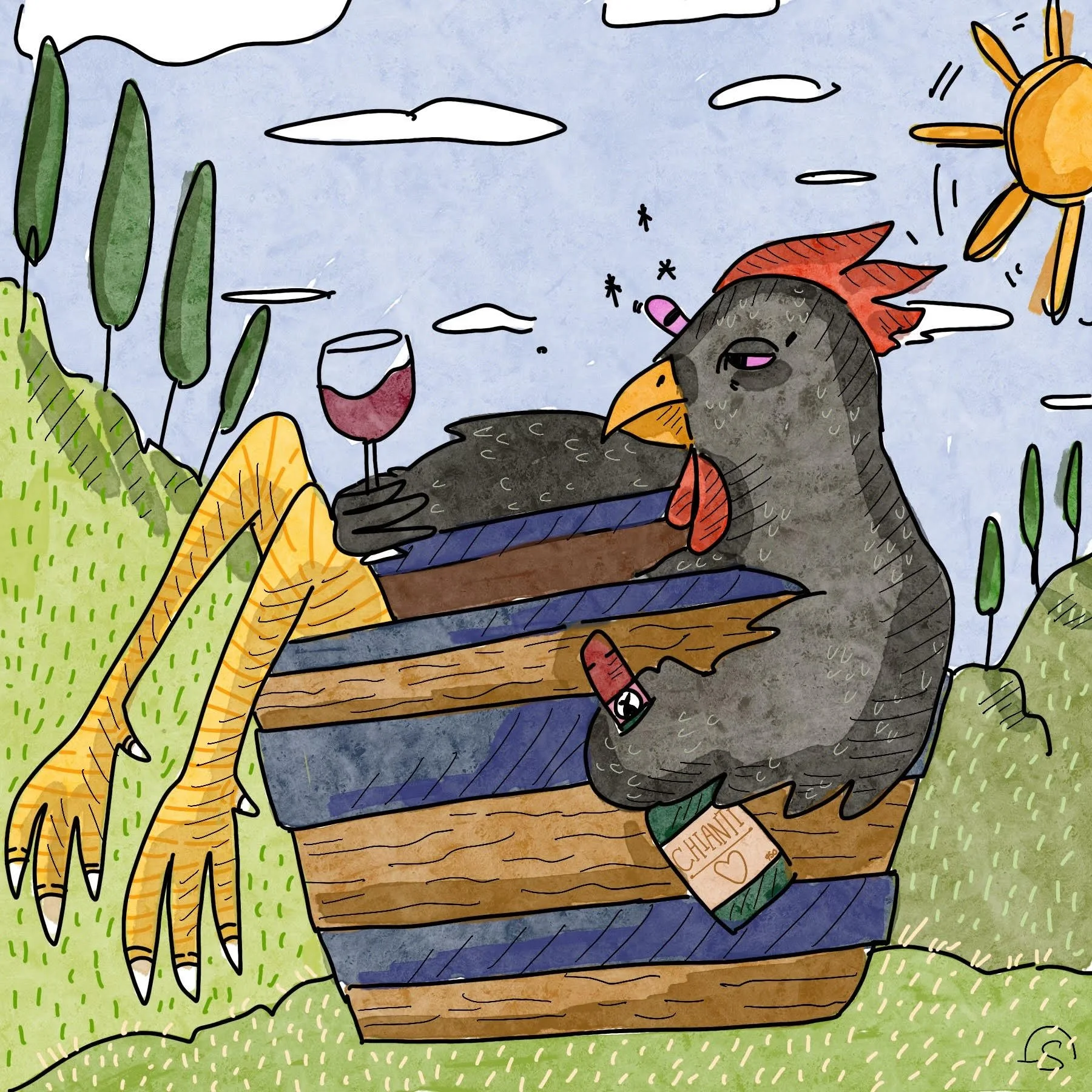The Tale of the Gallo Nero: An Introduction To Chianti Classico
Written by Luis Rivera
Illustration by Soraya Javan
What’s a trip to Tuscany without experiencing everything that Chianti has to offer?
For those reading that might not be familiar, Chianti is a region in Tuscany, Italy, intertwined between Florence, Siena and Pisa. Although there are 11 DOCG’s in Tuscany, we’re going to be focusing on an all time favorite of mine - Chianti Classico.
Chianti Classico is an appellation situated between Florence and Siena and is the only DOCG that has an animal as its emblem: the black rooster, or Gallo Nero.
The Tale of the “Gallo Nero”
The Gallo Nero, or simply, the black rooster, is linked to an ancient tale that dates back to the 13th Century. The tale tells the story of how one city outwitted another in order to control a strategic piece of land: Chianti.
It all starts with Florence, located in the North, and Siena, located in the South. For years, they battled for control over the land situated between them but, one day, they decided to put an end to the bloody clashes and resolve the dispute once and for all. How mature of them.
Each city would select their greatest knight, but instead of fighting to the death to determine where the border would be lined, they would do something surprisingly unexpected. At sunrise, the knights would depart from their respective cities and ride in the direction of the other. The border would be determined by the point at which they cross paths. The two cities depended on the crow of a roster to determine the start time. The Senese chose a white rooster that they fed very well and the Florentine’s selected a black rooster that they, well, let's just say PETA wouldn’t be too fond of their treatment.
When it was finally race day, it was clear who had developed a better strategy. The Florentine’s rooster, the Gallo Nero, could not have been more pissed off. Picture the scene in Step Brothers when Brennan touches Dale’s drumsticks. Now multiply Dale’s anger by 100. That’s how provoked this rooster was.
Once released, the Gallo Nero began to sing well before the sun rose. Unfortunately for the Senese, their rooster waited patiently until first light. This head start gave the Florentine’s the lead that they needed to take control of nearly the entirety of the Chianti area all thanks to the Gallo Nero.
The Main Grape of Chianti Classico
Sangiovese is the most important grape in Tuscany. In order to put Chianti Classico on the bottle, 80% of the wine that goes into the bottle needs to be sangiovese and the remaining 20% can be native grapes to the region, or international grapes like Cabernet Sauvignon or Merlot . The old recipe used to allow white grapes but in order to improve quality, they did away with that in 2006. When we take a closer look into Chianti Classico, there are three tiers based on aging and levels of quality.
Chianti Classico Quality Tiers
Annata
Annata represents the most standard type of Chianti Classico. Annata translates to vintage year - the year the grapes were harvested - which literally translates to year. Annata is usually the most affordable and they are the wines that you want to order with dinner. Since they only age for 12 months before release, they tend to open up quicker, there’s no need to decant and they’re also the most pure.
Riserva
Riserva is a step up from Annata. Riserva wines are aged for at least 24 months in the barrels and at least 3 months in the bottle before they are allowed to be released into the market. Although they tend to be more on the pricey side, bring to any dinner party and everyone will surely love you for making their night that much better.
Gran Selezione
The newly categorized tier of Chianti Classico is Gran Selezione, which was decreed in 2014 to designate the superior qualities that this wine encompasses. This is seen as the top category for the region and is the strictest in terms of using Gran Selezione on the label. Unlike Annata and Riserva, the grapes used for Gran Selezione must be 100% from the winery and not purchased from other growers. The top grapes from each winery typically go into the cuvée and the aging requirements increase from 24 months to 30 months before it’s allowed to be released.
Aging Chianti Classico
A common question that’s always asked is if you can age Chianti Classico. The answer to that is yes, you absolutely can. Having worked most of my career in Italian restaurants, I have had the surprise and pleasure of being able to taste some exceptionally older Chianti Classico’s. Sangiovese is a grape varietal that keeps acidity really well which I believe is the number one factor in wine ageability.
Next time you find yourself in a wine shop, keep an eye out for the following producers who have some fantastic Chianti Classico’s in the market:

